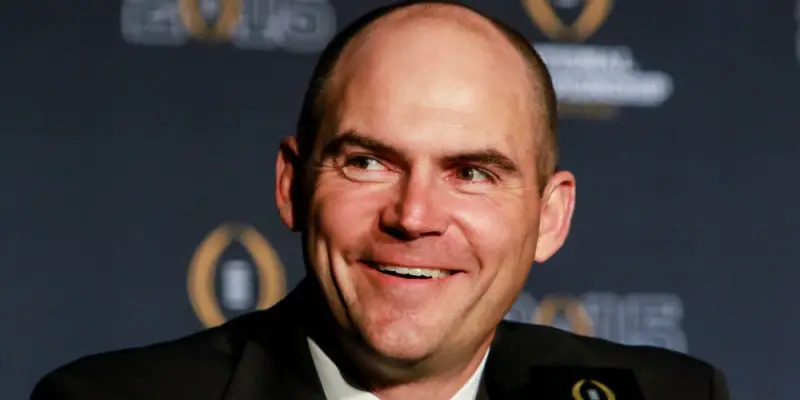In the beginning, Oregon’s 2017 season did not feel like its disastrous 2016 season, which resulted in the firing of the entire coaching staff. A new coach had already won the recruiting season by convincing key veterans to return (Royce Freeman and Tyrell Crosby), bringing in a stellar 2017 class and building the foundation of an historic 2018 class.
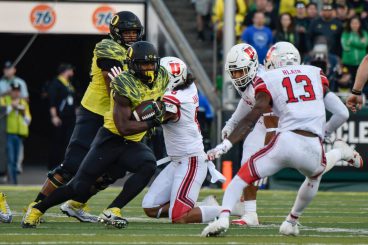
Crosby and Freeman: the most important recruits of all.
But after eight weeks, the Ducks had only one more win than they did at the same point in 2016 and looked like they might miss the postseason yet again. What was more concerning was that the tone of Oregon’s losses seemed reminiscent of 2016. While Oregon’s 2016 struggles were entirely on defense (the team never scored less than 21 last year) and the 2017 struggles have been on offense (the Ducks failed to score 21 three times in a row heading into week nine), the old frustrations of repeated mistakes and coaching errors suggested that the ghost of Mark Helfrich may have been possessing Willie Taggart‘s body. Oregon players seemed fueled by anything but Taggart’s patented “juice.”
But in week nine, Oregon plastered Utah 41 to 20. The victory is notable not only because it brings the Ducks one step closer to bowl eligibility, but also because Oregon showed signs of genuine adjustment on offense and continued success on defense.
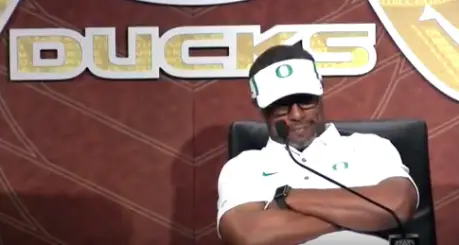
Willie Taggart enjoying the Utah postgame.
Offensive Innovation
Charles covered this better in his FishWrap than I ever could, but the Utah game revealed that Taggart is adjusting to Pac-12 competition. After multiple games of unimaginative play-calling, sending Freeman “up the gut” time after time, Taggart called a Charles Nelson touchdown pass to Jacob Breeland. If going from repeated inside run plays to a trick pass play doesn’t signal a shift in offensive philosophy, I don’t know what does. But that was just the tip of the iceberg.
Against California, the Ducks managed to win even after Herbert was injured because they racked up 328 rushing yards and five rushing touchdowns. They were able to generate that much on the ground because the offensive line dominated Cal’s defense.
But against Utah, Oregon managed 347 rushing yards not because its offensive line dominated the interior of the Utah defensive line, but because the Ducks ran to where the defense was weak. Taggart’s play calling didn’t demand blind execution against a faceless defense. Rather, Taggart took what the defense was giving him with numerous running plays to the edge.
In the passing game, Braxton Burmeister threw for only 47 yards, but was 9 for 12 passing. The designed pass plays also showed some innovation. Many of the called passes utilized Burmeister’s mobility by getting him out of the pocket and throwing on the run. He appeared much more comfortable on the move, and even though his yard total was not impressive, his completions came at important moments and kept the Utah defense on its heels.
Defensive Success
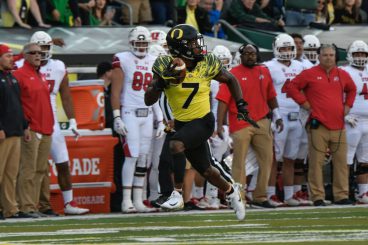
Ugochukwu Amadi with the defensive play of the year.
The 2017 Ducks defense has not been flawless. After all, it gave up 49 points to Stanford. But in 2016, the defense only once held an opponent under 28 points (Virginia in week 2). It has already achieved that goal in four games (Southern Utah, Wyoming, California and Utah). Even a casual fan should notice that defensive improvement. And Oregon’s defensive success is a departure from the past in two ways.
First, the defense is succeeding while playing many true freshman. As Charles pointed out, Deommodore Lenior, Nick Pickett, Brady Breeze, Thomas Graham, Jordon Scott and even Austin Faoliu all played significant minutes (sometimes together!) without a significant drop-off. As I wrote several weeks ago, this coaching staff not only recruits well, but also appears to develop players quickly. And this doesn’t only apply to freshmen …
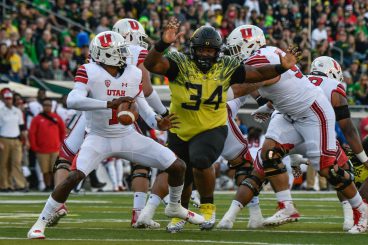
Jordon Scott has been a force in the interior.
Second, playmakers have emerged on defense. Jalen Jelks has been a revelation this season, and other playmakers are beginning to emerge as they internalize the quality coaching they are receiving. Arrion Springs, who has had an up-and-down career, looked like a lockdown corner against Utah. And who can ignore the emergence of La’Mar Winston Jr. over the past several weeks? He has looked tremendous at the “Duck” position and traditional outside linebacker as well.
What This Means
One of my concerns after the first three games of the season was that Taggart would be stubborn and resistant to adjustment. While he is not the most flexible coach, the Utah game largely allays those fears.
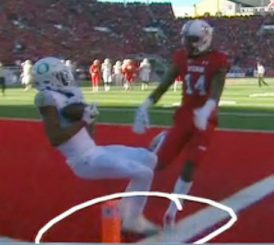
Darren Carrington with the dagger.
A word of caution: Even in the doldrums of last year, Oregon was able to beat Utah (though not as emphatically) on a miraculous catch by Darren Carrington. At that time, the victory over Utah seemed like the last gasp of the Helfrich regime. This victory, however, has a different tenor entirely.
While the Utah victory does not mean that Oregon fans will never again find reason to panic, it shows that Taggart is not satisfied with trying the same things and getting the same suboptimal results. But the past several games also indicate that he’s not one to make premature adjustments. Striking that happy medium should minimize the need for Oregon panic.
Cody Lonning
Cheney, Washington
Top Photo Credit: John Sperry
Related Articles:
Oregon Enters Playoffs Better Off Than Last Year
Will The Coaching Carousel Kill Oregon's CFP Chances?
The Playoff Formula Hasn't Changed
Oregon Aims to Bury Dawgs, Punch Playoff Ticket in Rivalry Clash
Huskies Are the New Beavers, Stay In Your Lane Kiffin, and the Civil Apple Cup War
Oregon Football: The X-Factor Vs. Washington
Cody inherited all his sports allegiances from his grandfather, a long-time Eugene resident. Even though Cody graduated from law school at Berkeley, he remains a staunch Oregon fan. When he isn’t watching the Ducks, Cody is hiking, engaged in various home-improvement projects, or writing about politics. Cody grew up farming hay and wheat in Eastern Washington. Now, he practices law.

